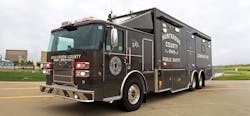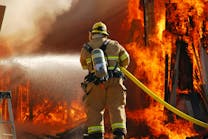MN Chief Wants Small Vehicles on EMS Runs
By Eric Roper
Source Star Tribune (Minneapolis)
Sept. 27 -- Calling 911 for medical problems in Minneapolis generates a big response. The city Fire Department dispatches a half-million-dollar fire engine with several firefighters, even for minor issues like a sprained ankle.
A smaller vehicle operated by the Minneapolis Fire Department may begin responding to some health emergencies around downtown next year, one way the department is dealing with its growing volume of medical emergency calls. The move would also help the department get reimbursed for some of its work.
The experiment, which could expand in the future, will be detailed at a City Council hearing on Thursday.
“It doesn’t really make sense to take a $500,000 fire truck to run down every one of these types of events,” Minneapolis Fire Chief John Fruetel told a community meeting Wednesday morning. “Some are just maybe a minor event, which is say a sprained ankle, for example, or somebody’s got a dislocated finger.”
A decline in fires and steady rise in medical calls are forcing fire departments across the country to reassess their emergency response. Roughly 75 percent of the calls received by the Minneapolis Fire Department last year were medical, totaling more than 35,000 calls, according to the department. Ambulances from hospitals are also dispatched.
Under the Mobile Integrated Healthcare project in partnership with Hennepin County EMS, certain calls would be routed to a new vehicle at Station 1 on Portland Avenue — potentially an ambulance, Fruetel said. That will save money on gas and maintenance for the giant rigs, though those vehicles would still respond to major health emergencies, like a heart attack. The department hopes it would allow them to provide reimbursable services, such as transferring patients.
“Hopefully there’s a way that we could start seeking not only some savings but a little bit of reimbursement for what we do,” Fruetel said. “Right now those 40,000 runs we go on, we do those for free. That’s a service we just provide.”
Council Member Steve Fletcher, who hosted Wednesday’s constituent meeting, is co-authoring an ordinance change to allow for the initiative, with Council Member Phillipe Cunningham.
The department is “frankly bursting at the seams, and sending a lot of people on runs that they don’t need to be going on,” Fletcher said.
Fruetel said the program may also evolve to include “community EMTs,” who visit patients discharged from the hospital to ensure they are prepared to follow doctors’ orders.
“We can do home visits on qualified patients. And we will get reimbursed for that,” Fruetel said.
Cunningham highlighted that a large portion of the country’s health care budget is wasted on unnecessary services.
“Efforts like these can prevent readmissions, reduce frequency of transports, and reduce overall emergency room visits,” Cunningham said in a statement. “Referring a patient to the ER outside of normal business hours is not sustainable nor does it lead to better outcomes for patients and the health care system.”
In 2013, former Mayor R.T. Rybak proposed sending fire staff in SUVs to medical calls as part of another pilot initiative in his final budget. It never happened.
Mark Lakosky, president of Firefighters Local 82, said the union viewed the 2013 proposal as part of an effort to scale back the department amid budget concerns — not grow it. The union has been more supportive of the new effort.
“If the premise works out and we get the data that says that certain pieces can be successful, and create revenue, and do what it’s supposed to, there’d certainly be more talk ... on implementing it at other places around the city,” Lakosky said.
Mayor Jacob Frey has proposed adding five positions to the fire department next year, totaling 419 staff, at a cost of $500,000. Fletcher expects two of those hires would be working on the pilot initiative.
At a recent budget hearing, Council Member Lisa Goodman expressed support for the initiative.
“Firefighters have become glorified EMS responders. And it’s an extremely expensive business for us to be in,” Goodman said. “Perhaps we need to be more aggressive in how we solve this problem.”
___ (c)2018 the Star Tribune (Minneapolis) Visit the Star Tribune (Minneapolis) at www.startribune.com Distributed by Tribune Content Agency, LLC.






